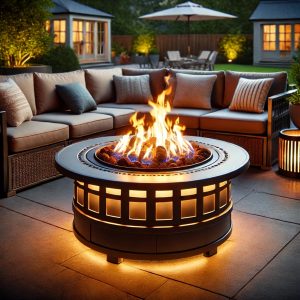Organizing a pantry can transform your kitchen experience. A well-planned pantry layout not only saves time but also enhances the efficiency of your cooking space. This article delves into practical tips and tricks to optimize your pantry layout. We aim to help you create a functional and aesthetically pleasing space. Let’s embark on this journey to streamline your pantry layout.
Contents
- 1 Understanding Your Space and Needs
- 2 Design Principles for an Effective Pantry Layout
- 3 Choosing the Right Storage Solutions
- 4 Organizing Strategies for Different Items
- 5 Maintaining an Organized Pantry
- 6 Innovative Pantry Layout Ideas
- 7 FAQ on Optimizing Pantry Layout
- 7.1 How do I determine the best pantry layout for my kitchen?
- 7.2 What are some tips for optimizing a small pantry layout?
- 7.3 Can I modify my pantry layout to accommodate bulk purchases?
- 7.4 What are the best practices for maintaining an efficient pantry layout?
- 7.5 How can I add more storage to my existing pantry layout?
- 7.6 What should I consider when choosing containers for my pantry layout?
- 7.7 How do I create a kid-friendly pantry layout?
- 7.8 Are there any innovative ideas for maximizing corner space in a pantry layout?
- 7.9 How important is lighting in a pantry layout?
- 7.10 Can I integrate technology into my pantry layout?
- 8 Conclusion
Understanding Your Space and Needs
Creating an efficient pantry layout starts with clearly understanding your specific space and needs. This is the foundation upon which all subsequent decisions are based. This section explores how to assess your pantry’s size and shape and identify your unique storage requirements.
Assessing the Size and Shape of Your Pantry
The first step in optimizing your pantry layout is to get a clear picture of the space you have. Measure the height, width, and depth of your pantry. Note unique features like deep corners, high shelves, or awkward angles. It’s not just the total space that matters, but how it’s shaped and what limitations it may present.
Consider the door’s swing and how it affects access. If you have sliding or folding doors, consider how they can enhance or restrict your layout options. Also, take into account any built-in features like existing shelves or drawers. They can be a starting point for your new layout.
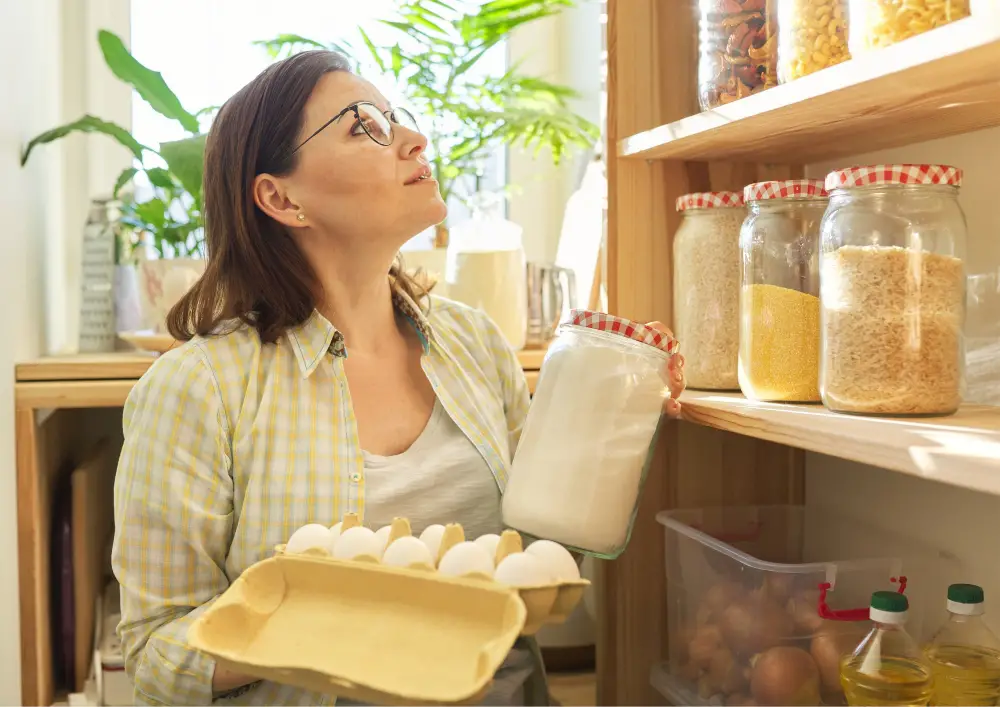
Identifying Your Storage Requirements
Your pantry should reflect your lifestyle and cooking habits. Start by listing the items you typically store in your pantry. Think about their size, shape, and how often you use them. This list will guide you in choosing the right storage solutions later.
Group your pantry items into categories like baking supplies, snacks, canned goods, and grains. This categorization helps create zones within your pantry, making it easier to find what you need. Pay special attention to bulky items or appliances that need a dedicated space.
Consider how your shopping habits influence your pantry layout. Buying in bulk means you’ll need more space for large items. If you shop more frequently for smaller quantities, you might prioritize accessibility over large storage spaces.
Your family’s needs are also crucial. If you have young children, you might want to create an easily accessible section for their snacks. If someone in your household has dietary restrictions, consider a separate area to store their food items.
Space Efficiency and Accessibility
Maximizing space efficiency is key to a well-organized pantry. Look for ways to use every inch of your pantry effectively. This might mean adding extra shelves, using stackable bins, or installing under-shelf baskets.
Accessibility is just as important as space efficiency. Your most frequently used items should be within easy reach. Reserve the higher and lower shelves for less commonly used items. This simple principle ensures you can quickly find and retrieve what you need.
Customization for Your Lifestyle
Your pantry should be a reflection of your lifestyle. If you are an avid baker, create a baking station with all your supplies and tools in one place. If you’re focused on healthy eating, place your whole grains, nuts, and seeds at eye level to encourage healthier choices.
Consider designated sections for each family member for households with varied tastes and preferences. This keeps things organized and allows everyone to find their favourite foods easily.
Design Principles for an Effective Pantry Layout
Crafting an effective pantry layout involves more than just arranging shelves and bins. It requires a thoughtful approach, combining aesthetics with functionality. This section delves into the key design principles that make a pantry practical and a joy to use.
Utilizing Vertical Space
One of the most overlooked aspects of pantry design is the effective use of vertical space. In many homes, the area above head height is underutilized. Installing shelves or hanging storage solutions up to the ceiling can dramatically increase your storage capacity. Adjustable shelving is particularly useful, allowing you to customize the space to suit different item heights.
For those hard-to-reach upper shelves, consider storing rarely used items or seasonal goods. Integrating a foldable step stool into your pantry design ensures you can safely access these higher shelves when needed.
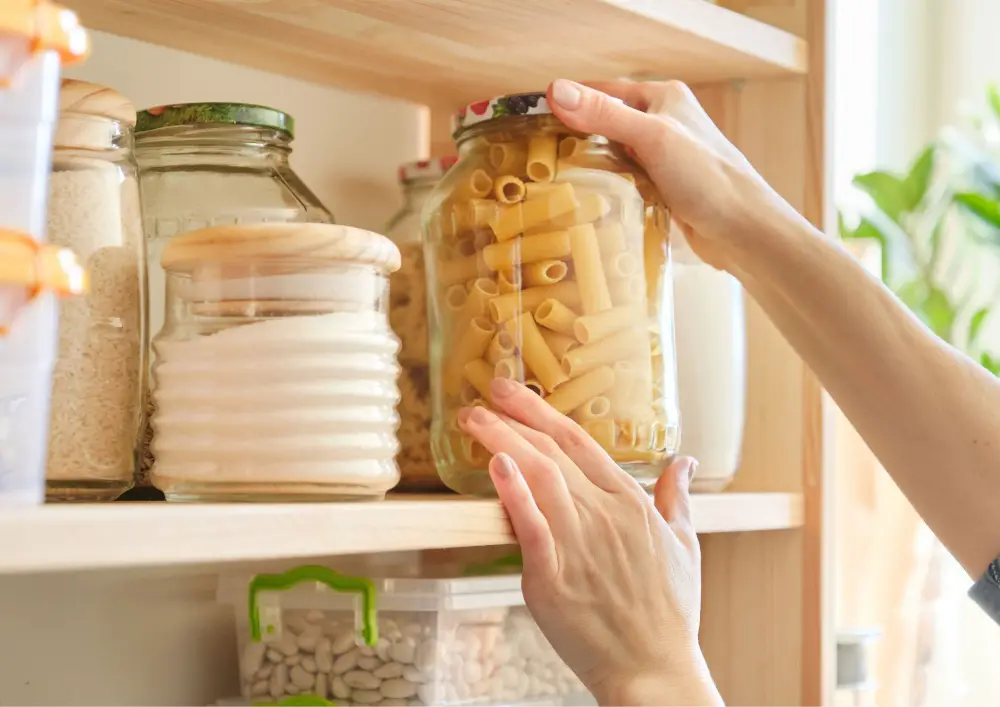
The Importance of Accessibility and Visibility
A well-designed pantry layout lets you easily see and reach every item. Avoid deep shelves where items can get lost at the back. Instead, opt for shallower shelves and use bins or pull-out baskets to prevent items from being hidden.
Clear storage containers are invaluable for visibility. They allow you to see what’s inside without opening every container. This is especially useful for dry goods like pasta, rice, and cereal. Labelling these containers adds another layer of organization, making it easy to find what you need.
Creating Zones for Efficiency
Dividing your pantry into zones based on use or food type is a great way to increase efficiency. For instance, have a zone for baking supplies, another for breakfast items, and yet another for canned goods. This approach not only makes it easier to find items but also helps in putting groceries away.
Consider the flow of your cooking and meal preparation when deciding on these zones. Place the items you use most often at eye level and in the most accessible spots. Less frequently used items can be stored higher up or in less accessible areas.
Incorporating Flexibility
Your needs and habits may change over time, so it’s important that your pantry can adapt. Choose storage solutions that can be easily adjusted or reconfigured. Modular shelving, stackable bins, and baskets are excellent options as they can be rearranged to suit changing needs.
Also, consider the versatility of each storage solution. For example, a wine rack can be repurposed for storing water bottles, and a spice rack can be used for small jars and containers.
Balancing Aesthetics and Functionality
While the primary focus of a pantry is storage, aesthetics shouldn’t be overlooked. A visually appealing pantry invites you to use it and maintain its organization. Choose a colour scheme that complements your kitchen, and consider adding under-shelf lighting to enhance the ambience and improve visibility.
Choosing the Right Storage Solutions
Selecting the right storage solutions is crucial for an effective pantry layout. The type of storage you choose should complement your pantry’s size, lifestyle, and the items you need to store. This section explores various storage options and their benefits, helping you make informed decisions for your pantry.
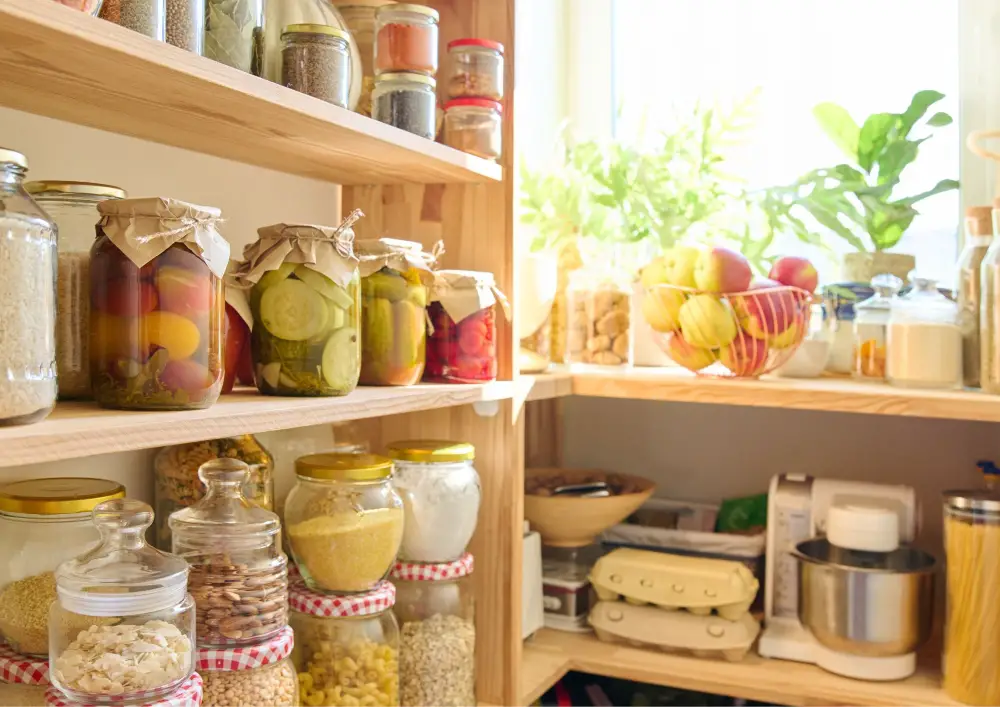
Types of Shelving and Their Benefits
Shelving is the backbone of any pantry. The type you choose can greatly impact the overall functionality of the space.
- Adjustable Shelving: Allows you to change the height of the shelves based on what you need to store. This flexibility is ideal for accommodating items of varying sizes.
- Fixed Shelving: Offers stability and is ideal for storing heavy items. Ensure the spacing is appropriate for your needs.
- Pull-out Shelves: Pull-out shelves are excellent for deep pantries, allowing easy access to items at the back without reaching or moving other items.
- Corner Shelving: A great solution for using corner spaces in a pantry. Lazy Susans or corner units can maximize this often underutilized area.
Smart Use of Bins, Baskets, and Containers
- Bins and Baskets: These are ideal for grouping similar items for your pantry layout. They make it easy to pull out groups of items and put them back, maintaining order in your pantry.
- Clear Containers: Perfect for dry goods, they keep food fresh and allow you to see what’s inside without opening them. This visibility helps in quick identification and maintains an orderly appearance.
- Stackable Containers: Save space by stacking items vertically. They work well for items bought in bulk or storing multiple similar items in one area.
- Door-mounted Racks: Utilize the back of the pantry door for additional storage. These racks are perfect for spices, oils, and other small containers.
Custom Solutions for Unique Items
Sometimes, standard storage solutions don’t fit the bill for unique or bulky items. Custom solutions can be tailored to fit your specific needs.
- Wine Racks: These aren’t just for wine. They can store bottled beverages, oils, or even rolled kitchen towels.
- Under-shelf Baskets: Add extra storage under existing shelves. They’re great for small items like tea bags or snack bars.
- Hanging Storage: Utilize the ceiling or high-up space for hanging storage for pots, pans, or utensils, freeing up shelf space for other items.
Integrating Technology
Modern pantries can benefit from the integration of technology.
- Automated Lighting: Lights that turn on when the door opens add a wow factor and improve visibility.
- Smart Inventory Systems: For the tech-savvy, smart inventory systems can track what you have, and what’s running low or even suggest recipes based on the contents of your pantry.
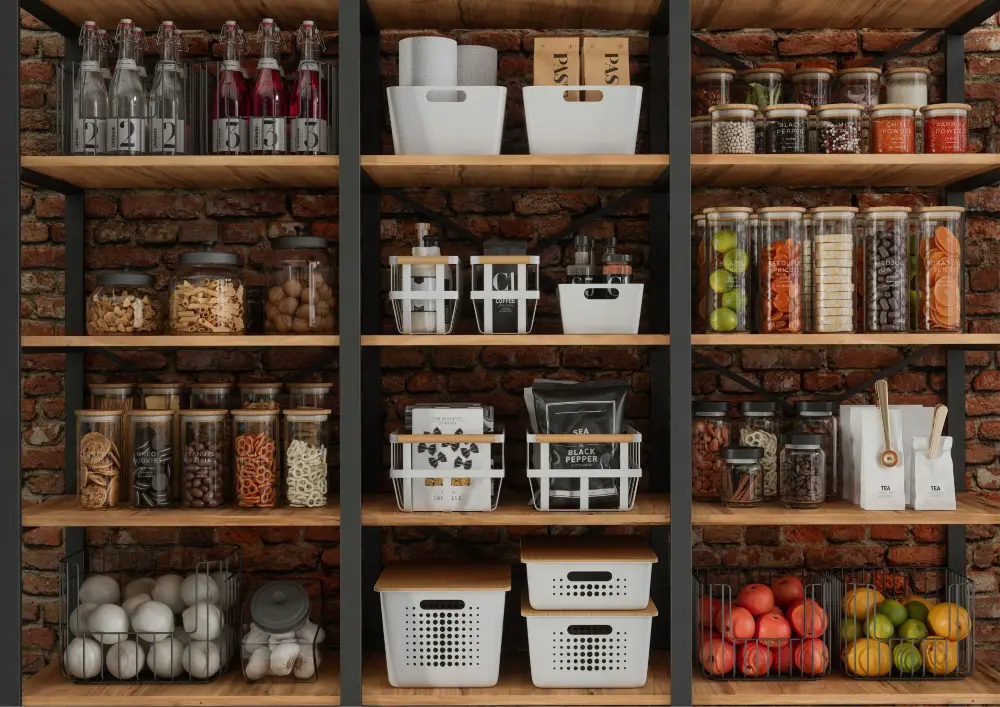
Organizing Strategies for Different Items
A well-organized pantry saves time and makes cooking and meal planning more efficient. This section focuses on strategies to organize different types of items in your pantry, ensuring everything is easily accessible and well-maintained.
Best Practices for Storing Dry Goods
- Use Clear, Airtight Containers: Store flour, sugar, rice, and other dry goods in clear, airtight containers to keep them fresh and prevent spills. This also makes it easy to see when supplies are running low.
- Label Everything: Labels are crucial for quickly identifying contents, especially for similar-looking items like different types of flour or grains.
- Group Similar Items Together: Keep all baking ingredients together, all breakfast items in another area, and so on. This grouping makes finding everything you need for a specific task easier.
Creative Solutions for Spices, Cans, and Snacks
- Spice Storage: Use a tiered spice rack or drawer inserts to store spices. This keeps them visible and easily accessible. Alphabetical organization can be helpful.
- Can Organization: Stackable can racks or bins help keep cans organized and prevent them from getting lost in the back of the pantry. Organize them by type (vegetables, soups, etc.) or by expiration date.
- Snack Storage: Use baskets or bins for snack storage. This makes it easy for family members to find what they want and helps maintain order.
Storing Bulk Items and Less Frequently Used Products
- Dedicate Space for Bulk Items: Store bulk items like paper goods or large packages in a designated area, preferably on lower or higher shelves not at prime real estate.
- Seasonal or Rarely Used Items: Store these items on the highest shelves or in another less accessible pantry area. Remember to label them clearly for easy identification.
Special Considerations for Fresh Produce
- Ventilated Storage: Some produce, like onions and potatoes, are best stored in a cool, dark pantry. Use ventilated baskets or bins to prevent spoilage.
- Separate Certain Fruits and Vegetables: Some fruits emit gases that can cause other produce to ripen quickly. Store these separately to extend freshness.
Utilizing Door and Wall Space
- Door Racks: Use door racks for storing smaller items like spices, condiments, or baking supplies.
- Wall-mounted Holders: Utilize wall space for hanging storage of utensils, aprons, or frequently used tools.
Maintaining an Organized Pantry
An organized pantry is key to a smooth-running kitchen. However, maintaining this order requires ongoing effort. This section provides tips on how to keep your pantry layout efficient and orderly over time.
Regular Audits and Re-Organization
Set a regular schedule to go through your pantry. This could be monthly or with the change of seasons. Check for expired items, anything that’s running low, or items that are no longer used.
After each audit, take a moment to reorganize. This might mean moving items that have become more frequently used to a more accessible spot or adjusting shelves to accommodate new items.
Adapting to Changing Needs
Your needs may change with time. Be ready to adjust your pantry layout accordingly. What worked a year ago might not be the best solution now.
If you live with others, get their input on the pantry organization. They might have ideas or needs that you haven’t considered.
Keeping It Clean and Tidy
Wipe down shelves, bins, and containers regularly. This not only keeps your pantry looking good but also prevents pests. After grocery shopping, take a few extra minutes to put things away properly. It’s easier to maintain order than to reorganize a cluttered pantry.
Labeling and Inventory Management
If you change what’s in a container, update the label. This helps everyone in the household find what they need. Consider keeping a running inventory of your pantry items. This can be as simple as a list on the pantry door or a digital inventory on your phone.
Incorporating New Products and Trends
As new storage solutions and products come onto the market, be open to incorporating them into your pantry. Occasionally check blogs, magazines, or social media for new organizing tips and trends. You might find a solution that’s perfect for your pantry.
Innovative Pantry Layout Ideas
Exploring innovative ideas can take your pantry layout to the next level. This section highlights creative and practical solutions implemented in well-designed pantries. These ideas can inspire you to adapt and customize your pantry to fit your lifestyle and space.
Case Studies of Well-Designed Pantries
- The Corner Carousel: A pantry with a corner carousel makes excellent use of corner space, providing easy access to items that would otherwise be hard to reach.
- Pull-out Pantry Shelves: In a narrow pantry, pull-out shelves offer great visibility and accessibility. They slide out like drawers, allowing you to see everything at once.
- Vertical Dividers for Baking Sheets and Cutting Boards: Vertical storage dividers provide an organized way to store flat items like baking sheets, cutting boards, and serving trays.
- Integrated Workstation: A pantry with a built-in workstation, including a small countertop and outlets, can be a game-changer. It’s perfect for small appliances or as an additional prep area.
Adapting These Ideas to Your Space
- Modular Shelving Systems: These systems allow for a high degree of customization. You can add or remove shelves and other components as your needs change.
- Utilizing Wall Space: Install hooks or pegboards on empty wall space for hanging utensils, aprons, or small pots and pans.
- Under-shelf Lighting: Adding lighting under shelves improves visibility and enhances the overall look of the pantry.
- Custom Drawer Organizers: Tailor your drawer organizers to fit your items. This is especially useful for keeping smaller items neatly arranged.
Incorporating Technology
- Smart Storage Solutions: Consider incorporating technology like smart jars or containers that track the freshness of your food or remind you when supplies are low.
- Mobile App Integration: Use apps to keep track of inventory, recipes, or shopping lists. This can be particularly helpful in maintaining a well-organized pantry.
Eco-Friendly and Sustainable Options
- Reclaimed Wood Shelving: Use reclaimed wood for your pantry shelving for a rustic and eco-friendly look.
- Bulk Dispensers: Installing bulk dispensers for items like grains, nuts, or cereals can reduce packaging waste and make it easier to buy in bulk.
FAQ on Optimizing Pantry Layout
How do I determine the best pantry layout for my kitchen?
The best pantry layout depends on your kitchen’s size, storage needs, and how you use your pantry. Start by assessing the space available and consider how you can maximize it, keeping in mind the accessibility of items. A well-planned pantry layout should balance functionality with aesthetics.
What are some tips for optimizing a small pantry layout?
Focus on vertical storage solutions like tall shelving units and over-the-door racks for a small pantry layout. Use clear, stackable containers to maximize space and keep items visible. Pull-out drawers can also enhance accessibility in a compact pantry layout.
Can I modify my pantry layout to accommodate bulk purchases?
To accommodate bulk purchases in your pantry layout, allocate specific areas for large items. Use deep shelves or baskets for bulky goods, and consider adjustable shelving to adapt the space as needed. This approach ensures that your pantry layout remains flexible and functional.
What are the best practices for maintaining an efficient pantry layout?
Regularly declutter and reorganize the space to maintain an efficient pantry layout. Label all items and ensure everything has a designated place. Periodically review and adjust your pantry layout to suit changing needs and preferences.
How can I add more storage to my existing pantry layout?
Enhance your existing pantry layout by adding under-shelf baskets, door-mounted racks, and wall hooks. Consider adding a freestanding shelf unit or a pull-out cabinet if space allows. These additions can significantly increase storage in your current pantry layout.
What should I consider when choosing containers for my pantry layout?
In your pantry layout, choose containers based on size, transparency, and stackability. Airtight containers are best for preserving freshness. Clear containers allow for easy identification of contents, and stackable designs save space in your pantry layout.
How do I create a kid-friendly pantry layout?
For a kid-friendly pantry layout, create lower storage areas that are easily accessible to children. Use sturdy, spill-proof containers and organize snacks and other items at their eye level. This approach makes it easier for kids to find what they need without disrupting the overall pantry layout.
Are there any innovative ideas for maximizing corner space in a pantry layout?
To maximize corner space in your pantry layout, consider carousel shelves or Lazy Susans. These solutions allow for easy access to items stored in the corners. Pull-out corner units can also effectively utilize every inch of your pantry layout.
How important is lighting in a pantry layout?
Good lighting is crucial in a pantry layout. It enhances visibility, making it easier to find items. Consider installing under-shelf lighting or LED strip lights to illuminate your pantry layout effectively.
Can I integrate technology into my pantry layout?
Technology can be a great addition to your pantry layout. Smart inventory systems, automated lighting, and apps for managing pantry items can enhance the functionality and convenience of your pantry layout.
Conclusion
Optimizing your pantry layout is more than just an organizational task; it’s about creating a space that supports your lifestyle and enhances your cooking experience. Remember, the perfect pantry layout works for you and your family, making every cooking endeavor more pleasurable and less of a chore.

